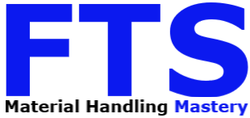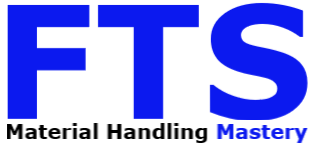Could ‘normality’ be another word for ‘comfort’? Maybe not in most aspects of life, but in the world of lift-truck operations, it most certainly can be.
In the industrial workplace, where there are typically lift trucks being operated, normalcy is more often than not a form of comfort because of the numbness to potential hazards. The potential hazard ignored through numbness then becomes a real hazard. One example of this is the high comfort level of most people which is shown by how close they get to lift trucks in operation. The lift truck operating in the same building as people is a potential hazard until someone walks by it, then it becomes a real hazard. So why would someone walk next to a 9,000# machine that could maim or kill them? Because it’s normal, and therefore they have become perfectly comfortable with it.
The next question is, in regards to forklift operations, what can normalcy kill? You may think the answer is obvious, but it isn’t. People can be killed in forklift operations, but there are 3 other casualties of normalcy which are personal protection, employee morale, and the company’s bottom line. Shockingly, this all before the accident happens.
Let’s examine the 3 casualties of normality below.
Casualty of Normality #1-Personal Protection Awareness
In short, Personal Protection Awareness (PPA) is knowing and paying attention to what you are doing. PPA is the antithesis of numbness. Normal activities where workers are interacting in and around lift truck operations typically have a lowered PPA. This is because the act of dropping your guard once, and nothing negative happens will cause a rewiring of the subconscious mind. This is where the brain is literally reprogrammed subtly to be disregardful of the potential hazard and then turn it into a real hazard.
Disregardfulness caused by normality creates a new normal. The new normal, subtle and hidden, is invariably one with an increasing number of day-to-day hazards. The new normal is one where operators do less verification before driving into docked trailers, don’t look before they back up, stop wearing their seatbelts, and pedestrians stand toes-to-tires with operating forklifts. It doesn’t get this way in a day, but it takes time, and that sleepy creepy silent killer of normality keeps even the most zealous of managers from recognizing it.
Not only do one’s habits make their habits worse, but they are more contagious than a yawn. That’s right, normality is not a victimless crime. Normality will chip away at your PPA just by presenting a real hazard as if it were nothing unusual, like when a truck driver stands 1 foot away from the lateral in of the load coming off of the truck bed. In some places, that is completely normal, and the more people that see it, the more people it becomes normal.
Casualty of Normality #2-Workplace Morale
Normality causes a lowered morale, not by hum-drum, but by overwhelming the senses with hazards and worry, irritated supervisors and workers, and equipment constantly in disrepair.
Normality does dull the mind to hazard, but then the new normal evolves into regular near misses. This new scene is the one with the fast and sudden maneuvering, the dropped loads, and the almost ran-over workers. Over time, it becomes unbearable for workers, and then the chronic turnover begins.
Combine the near misses with the tension between management and operations personnel and the equipment that is frequently in need of some kind of repair, and the workplace can become a nightmare for all.
And speaking of that broken equipment, that takes us to the next casualty.
Casualty of Normality #3-The Bottom Line
What everyone knows is that the bottom line is always affected by lackluster care of lift trucks, and wiped out by injuries. What few know is that the underlying problem of normality is killing the bottom line slowly, more with each passing day.
For starters, as forklifts age, they become more susceptible to brake downs and needed repairs. As normality evolves and strengthens, it expedites the aging of the lift trucks. As operators become more complacent, they tend to be rougher with the machines. As the decline continues, the forks get dropped more, the tires get spun, the racks get dented and broken, the product gets backed into, and the pre-shift inspections are forgotten. This all becomes “unplanned” expenses and anyone who has seen a bill for forklift repairs should start to understand the reality of normality.
Next, there are the personnel issues that occur as a result of the high turnover brought on by prolonged complacency. The issue is hard on HR and Safety professionals along with those who manage the operations and production, as well as it is expensive. Not only that but having a constant cycle of new people means that there is the need for constant training and potentially excessive rework which can be disastrous to both production schedules and customer relations directly.
Finally, there are accidents and injuries. Lift-truck injury accidents typically require a minimum of a trip to the emergency room, and in many cases at least one surgery. Injuries from forklift accidents often change people forever, and in many cases take them out of the workplace. Serious injuries in the workplace are extremely expensive and can put companies out of business. The cost of one injury, which can get into the millions, has a ripple effect that puts an increased strain on the company it occurred, and also the economy.
Killing the Normality That Kills
Knowing where you are is the key to knowing where to go. That’s why the first place to start is an honest assessment. A truly genuine inward will tell reveal how far down the path of numbness you are, and this revelation should be rooted in the scoring of habits. Habits are the result of attitude and awareness. Daily habits make us who we are, and they certainly make the workplace what it is. The purpose of assessment is too blindingly clear what the culture of a particular workplace truly is; hazard causing, or hazard eliminating.
After a workplace assessment is done, then it’s time to discuss leadership and training. By leadership, I mean the capacity of the people in that particular workplace to grow in leadership. Everything rises and falls on leadership, and it will take intentional leadership to reverse the culture of comfort. Leadership capacity is really about attitude, just as habits are, and that is where the training comes in. A typical (another word for normal) safety training program will not accomplish leadership growth, nor will it have any lasting effect on the habits that increase the risk of accidents and injuries. Both the assessment and the training must be highly intentional about finding hazardous habits and eliminating them. In other words, you need to know how much of your PPA is gone, and then be aggressive about re-instilling it.
The obvious questions now are;
Ø Is your company normalizing hazards?
Ø How is normality costing you?
Ø What’s the real cost you if you don’t recognize it?
Ø How can you reverse the downward spiral of normality?
Answering those questions means striving for material handling mastery, and you may find that you cannot afford anything less than mastery.
Thank you for reading and remember that the right path starts with assessment.
By Dustin Link






